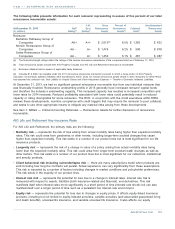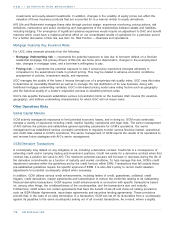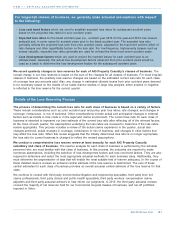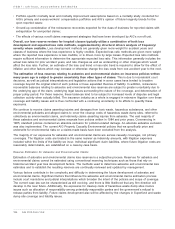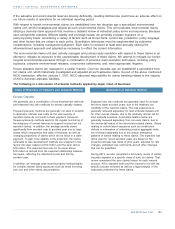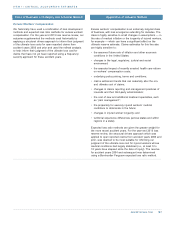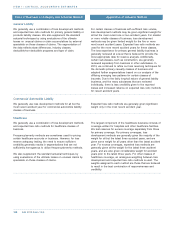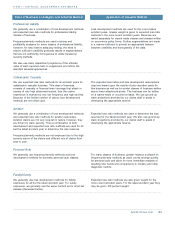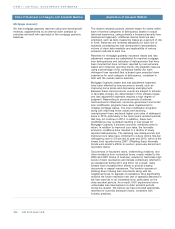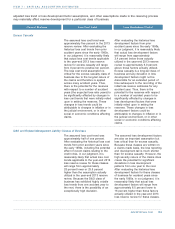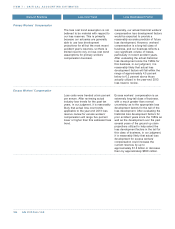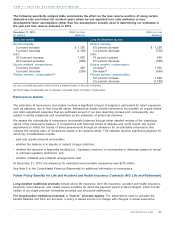AIG 2013 Annual Report Download - page 203
Download and view the complete annual report
Please find page 203 of the 2013 AIG annual report below. You can navigate through the pages in the report by either clicking on the pages listed below, or by using the keyword search tool below to find specific information within the annual report.
If the asbestos and environmental reserves develop deficiently, resulting deficiencies could have an adverse effect on
our future results of operations for an individual reporting period.
With respect to known environmental claims, we established over two decades ago a specialized environmental
claims unit, which investigates and adjusts all such environmental claims. This unit evaluates environmental claims
utilizing a claim-by-claim approach that involves a detailed review of individual policy terms and exposures. Because
each policyholder presents different liability and coverage issues, we generally evaluate exposure on a
policy-by-policy basis, considering a variety of factors such as known facts, current law, jurisdiction, policy language
and other factors that are unique to each policy. Quantitative techniques must be supplemented by subjective
considerations, including management judgment. Each claim is reviewed at least semi-annually utilizing the
aforementioned approach and adjusted as necessary to reflect the current information.
The environmental claims unit also actively manages and pursues early resolution with respect to these claims in an
attempt to mitigate its exposure to the unpredictable development of these claims. We attempt to mitigate our known
long-tail environmental exposures through a combination of proactive claim-resolution techniques, including policy
buybacks, complete environmental releases, compromise settlements, and, when appropriate, litigation.
Known asbestos claims are managed in a similar manner. Over two decades ago we established a specialized toxic
tort claims unit, which historically investigated and adjusted all such asbestos claims. As part of the above mentioned
NICO transaction, effective January 1, 2011, NICO assumed responsibility for claims handling related to the majority
of AIG’s domestic asbestos liabilities.
The following is a discussion of actuarial methods applied by major class of business:
We generally use a combination of loss development methods Expected loss ratio methods are generally used for at least
and expected loss ratio methods for excess casualty classes. the three latest accident years, due to the relatively low
credibility of the reported losses. The loss experience is
Frequency/severity methods are generally not used in isolation generally reviewed separately for lead umbrella classes and
to determine ultimate loss costs as the vast majority of for other excess classes, due to the relatively shorter tail for
reported claims do not result in claim payment. (However, lead umbrella business. Automobile-related claims are
frequency/severity methods assist in the regular monitoring of generally reviewed separately from non-auto claims, due to
the adequacy of carried reserves to support incurred but not the shorter-tail nature of the automobile-related claims. Claims
reported claims). In addition, the average severity varies relating to certain latent exposures such as construction
significantly from accident year to accident year due to large defects or exhaustion of underlying product aggregate limits
losses which characterize this class of business, as well as are reviewed separately due to the unique emergence
changing proportions of claims which do not result in a claim patterns of losses relating to these claims. The expected loss
payment. To gain more stability in the projection, the claims ratios used for recent accident years are based on the
amenable to loss development methods are analyzed in two projected ultimate loss ratios of prior years, adjusted for rate
layers: the layer capped at $10 million and the layer above changes, estimated loss cost trends and all other changes
$10 million. The expected loss ratio for the layer above that can be quantified.
$10 million is derived from the expected relationship between
the layers, reflecting the attachment point and limit by During 2013, we also completed a third party review of certain
accident year. insureds exposed to a specific class of toxic tort claims. That
review considered the prior claims history for each insured
In addition, we leverage case reserving based methodologies account, AIG’s exposed limits and the insured’s role with the
for complex claims/ latent exposures such as those involving specific toxicant reviewed as well as a legal analysis of the
toxic tort and other claims accumulations. exposures presented by these claims.
Excess Casualty
..................................................................................................................................................................................................................................
AIG 2013 Form 10-K 185
ITEM 7 / CRITICAL ACCOUNTING ESTIMATES
..................................................................................................................................................................................
..................................................................................................................................................................................
Class of Business or Category and Actuarial Method Application of Actuarial Method


